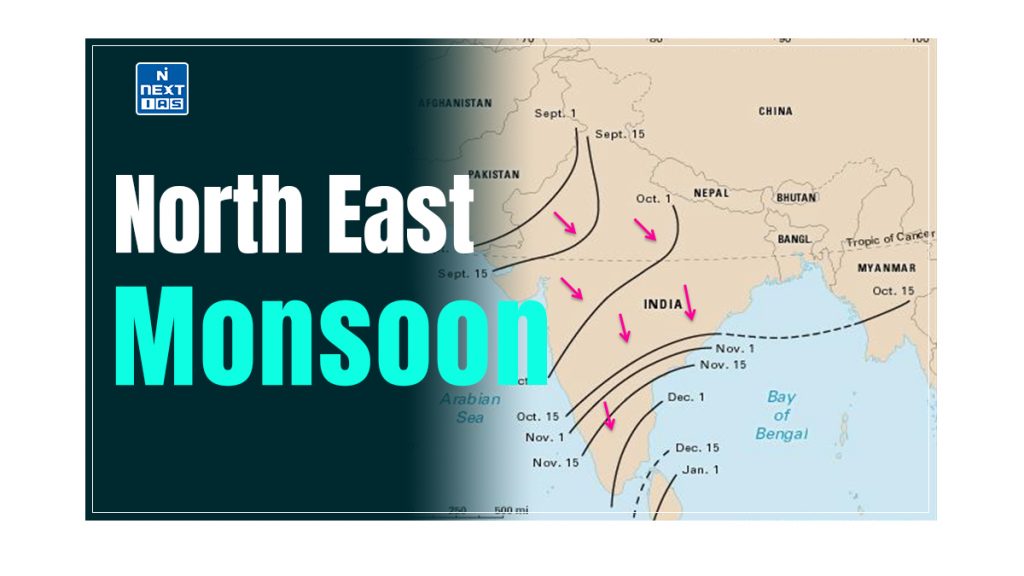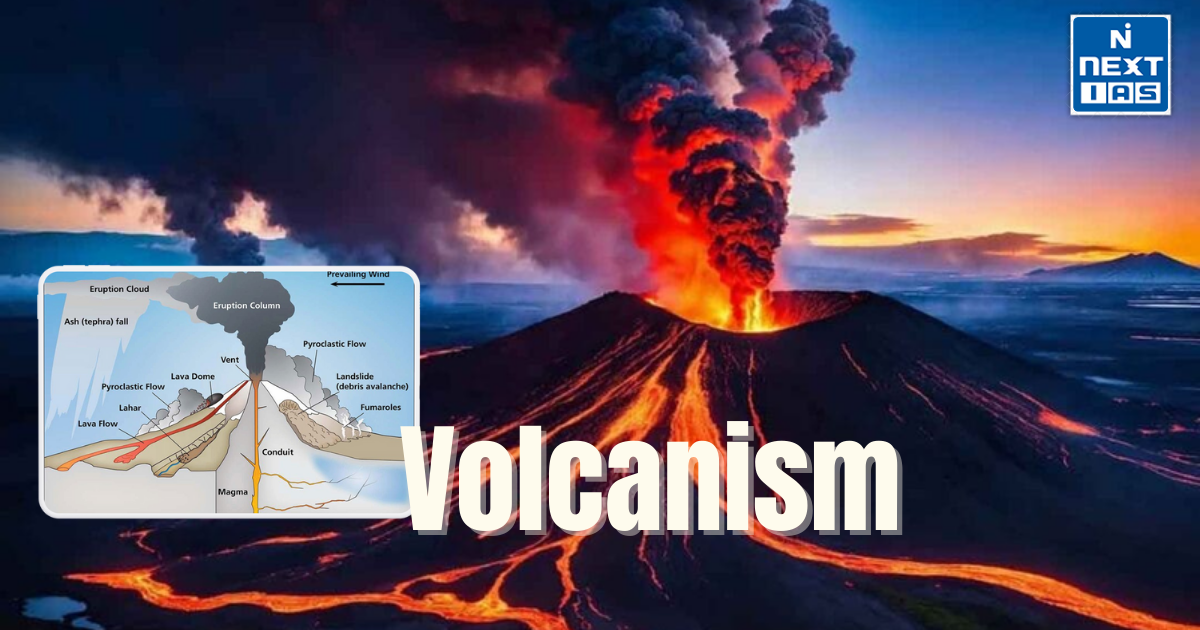
The North East Monsoon is a key climatic feature influencing southeastern India from October to December. It plays a crucial role in providing vital rainfall, especially in Tamil Nadu and adjoining areas, and helps moderate temperatures during the transition from the rainy season to winter. This article explores in detail the characteristics, impacts, and mechanisms of the Northeast Monsoon, along with its effects on regional weather patterns.
About Indian Monsoon
- The Indian Monsoon is a critical climatic phenomenon characterised by seasonal wind shifts that bring heavy rains to the Indian subcontinent.
- The Southwest Monsoon typically begins in June, bringing moisture-laden winds from the Indian Ocean, and continues until September.
- The Northeast Monsoon, occurring from October to December, affects southeastern India.
Read our detailed article on the Monsoon in India.
Read our detailed article on the South West Monsoon in India.
About North East Monsoon
- The Northeast Monsoon, also known as the Retreating Monsoon, occurs from October to December and is characterized by winds blowing from the northeast.
- This monsoon primarily affects southeastern India, including Tamil Nadu, and parts of the eastern coast.
- During this period, the northeast trade winds bring moisture from the Bay of Bengal, resulting in rainfall.
- The Northeast Monsoon is crucial for replenishing water supplies in regions with less rain during the Southwest Monsoon.
Characteristics of North East Monsoon
The features of North East Monsoon are:
- Timing and Duration – It occurs from October to December.
- It follows the Southwest Monsoon and marks the transition from the rainy season to the winter season.
- Wind Direction – It is characterised by northeast trade winds that blow from the northeastern directions towards the Indian subcontinent.
- Rainfall Distribution – It primarily affects the southeastern coast of India, including Tamil Nadu and parts of Andhra Pradesh.
- Rainfall is often less than the Southwest Monsoon but can be substantial in the affected regions.
- Impact on Weather – It brings cooler temperatures and helps reduce the heat of the preceding summer.
- It replenishes water resources in areas with little rain during the Southwest Monsoon.
- Rain Shadow Effect – The eastern coast of India, particularly Tamil Nadu, receives significant rainfall, while the regions to the west may experience dry conditions.
- Seasonal Variability – Rainfall can be variable, with some years experiencing heavier rains and others receiving less.
Mechanism of North East Monsoon
- During October and November, the sun’s movement towards the south shifts monsoon troughs or low-pressure systems towards the south.
- It results in the weakening of troughs over the Northern Plains.
- Also, the withdrawal of South West Monsoon winds, it leads to the development of a high-pressure system over that area, i.e., the cold winds swipe down from the Himalayas and Indo-Gangetic plains towards the vast span of the Indian Ocean.
- By the beginning of October, monsoons had withdrawn from the Northern Plains.
- The Northeast Monsoon then starts affecting Southeastern India.
October Heat
- October-November is a transition from a hot, rainy season to dry winter conditions.
- Monsoon retreat is marked by clear skies and a temperature rise.
- Day temperatures are high, while nights are cool and pleasant.
- However, since the land is still moist, the conditions of high temperature and humidity make the weather oppressive during the day.
- This is commonly known as ‘October heat’.
Cyclones during North East Monsoon
- After October 15, the mercury begins to fall rapidly, particularly in Northern India.
- Low-pressure conditions prevailing over north-western India get transferred to the Bay of Bengal by early November.
- This shift is associated with cyclonic depressions, commonly known as tropical cyclones.
- They originate over the Andaman Sea and the Bay of Bengal. Sometimes, they cross the eastern coasts of India, causing heavy and widespread rains.
- They are often very destructive and sometimes cause immense damage to life and property.
- Thickly populated deltas of the Godavari, the Krishna, and the Kaveri are frequently struck by these cyclones.
Impact of North East Monsoon on Tamil Nadu and Adjoining Areas
- The Northeast Monsoon also causes rainfall in Tamil Nadu and adjoining areas of Andhra Pradesh to the south of the Krishna Delta and Kerala (also called the second rainy period of Kerala).
- The retreating monsoon absorbs moisture while passing over the Bay of Bengal and causes this rainfall in the regions.
- Due to winter rainfall, Tamil Nadu coastal areas have developed dry evergreen forests.

Break in Monsoon
The monsoon tends to have ‘breaks’ in its rainfall, which causes wet and dry spells in July and August. This phenomenon is known as a ‘break in monsoon’. These breaks in different regions are due to various reasons:
- In northern India, rains are likely to fail if rain-bearing storms are infrequent along the monsoon trough or the ITCZ (Inter-Tropical Convergence Zone) in this region.
- Along the west coast, dry spells occur when winds blow parallel to the coast.
- Another important reason is an increase in the intensity of Tibetan high pressure.
- This results in the northward shifting of the monsoon trough.
- During the break period, the trough’s axis lies at the foothills of the Himalayas, causing heavy rainfall over the foothills on the southern slope while no rain occurs in the Gangetic Plains.
Conclusion
The Northeast Monsoon, occurring from October to December, significantly affects southeastern India by bringing crucial rainfall and cooler temperatures. While it helps replenish water resources, it also introduces variability and can cause cyclonic depressions with heavy rains. Understanding this monsoon is essential for effective management and preparation, particularly in regions impacted by its unpredictable nature.
Difference between South West Monsoon and North East Monsoon
| Aspects | South-West Monsoon | North-East Monsoon |
|---|---|---|
| Season | June to September | October to December |
| Wind Direction | Southwest to Northeast (SW -> NE) | Northeast to Southwest (NE -> SW) |
| Source of Moisture | Indian Ocean | Bay of Bengal |
| Regions Affected | Most of India | South Eastern Coast of India, esp. Andhra Pradesh and Tamil Nadu |
| Type of Rainfall | Heavy Rainfall | Moderate Rainfall |
Frequently Asked Questions (FAQs)
What is Retreating Monsoon?
The Retreating Monsoon, also known as the Northeast Monsoon, occurs from October to December when the southwest monsoon winds retreat, and the winds change direction to blow from the northeast.
Which state in India receives retreating monsoon?
The state in India that primarily receives rainfall from the retreating monsoon is Tamil Nadu. Additionally, parts of Andhra Pradesh also receive significant rainfall during this period.






